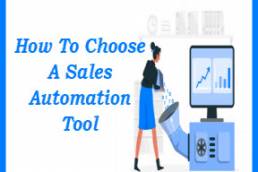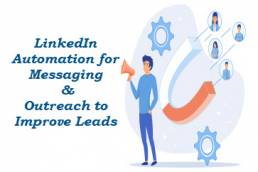Let’s start with a simple fact: If you want to generate leads, you need to create the best LinkedIn profile and be on LinkedIn.
The reasons are obvious:
- There are 870 million+ LinkedIn users.
- LinkedIn was voted the most trusted network in 2020.
- LinkedIn has 174 million U.S. Workers.
- There are 55 million companies on LinkedIn.
- LinkedIn has more conversion rate than Facebook and Twitter combined.
- 90% of B2B marketers use LinkedIn for B2B leads
- LinkedIn is solely responsible for 80% of B2B traffic.
These stats prove how important this network is. To use LinkedIn for brand awareness, marketing, and lead generation, you first need to create a top-notch profile.
Your profile serves as your digital business card. Think of it as a suit that you wear when meeting potential clients. So, you will wear the best clothes you have, look professional, and prepare a great pitch for your potential clients. The same works for LinkedIn profiles. Your profile should have all the professional elements that will convince the visitors you’re the perfect vendor for them.
When you send an invitation to someone, they first see your profile picture. If it is attractive enough, they will visit your profile and look for details such as:
- Who are you, and what do you do?
- What values do you offer?
- Why should they accept your connect request
- Do you offer any solution to their problems
As a B2B marketer or business owner, you run B2B campaigns often. Whether you do it using the LinkedIn automation tool or any other technique, you need a good profile. To generate 3x more leads and monetize your LinkedIn account, you need to start from your profile to get the job done.
Here’s how you can turn your LinkedIn profile into a revenue-making machine:
1. Get a Custom Profile URL
When a person creates a profile on LinkedIn, LinkedIn creates a string of numbers called a profile URL.
However, a user can also create a custom URL instead. If you want to create your custom URL, make sure it’s easy to share and remember.
Optimizing your LinkedIn URL can benefit you, but many people still skip this part.
It will take you a few minutes to edit your URL:
Use your name and initials in some specific format. You can also add key certification – CPA (Certified Public Accountant) or a PMP (Project Management Professional) to create an optimized URL.
If you keep the default URL, it will be a very long URL that contains your name and a random combination of numbers – not very convenient to share.
However, if you send your customized URL, it will look professional. As it has your name on it, people are more likely to click on it.
2. Add a Professional & Eye-catching Profile Picture
‘It’s common human psychology that they look at someone’s appearance first.’ It’s the appearance that decides whether they will accept or reject. When you send a connection request to someone or visit profiles, your profile picture is the first thing people will notice. Adding a professional profile picture can be a game-changer for you. It will govern the first impression you will leave on your prospects, good or bad. That’s in your hands.
Here are some tips to add profile pictures that will differentiate you:
Make sure you add a recent picture of yourself.
- Add a picture that looks professional and decent.
- Don’t add something funky or with Snapchat filters.
- It’s great if your face takes 60% of your profile picture.
- Don’t add long-distance shots that people can’t even recognize you.
- Add a picture with a smile to show friendliness and warmth.
- Try to click a picture with a working environment in the background to show authority.
3. LinkedIn Profile Banner That Reflects You
A profile banner is the second visual that shows up on the top. Many great LinkedIn profiles have backgrounds that give an idea about what they love and what matters to them the most.
So, make sure you add a meaningful and relevant background image of 800×200 px. If you’re adding something with text, ensure the whole text part is visible.
Your profile background makes you stand out, so select a picture wisely.
4. Write a Unique Headline That Rocks
Next comes the profile headline that appears right below your name. A headline could be a reason for prospects to visit your profile or ignore you, so write a good one. A good and relevant headline will also help you with networking on LinkedIn.
Put some thought into creating a perfect headline that combines who you are and what you can do for others. You can write about your current position and how you can contribute value. Keep your audience in mind and write something that will attract them.
Your current position + Company + How you can help.
Some excellent examples of profile headlines are:
1. B2B Marketing Expert | Helping B2B businesses to create leads through useful strategies.
2. Ready to grow your business? I Coach SaaS founders and help them accelerate their businesses.
3. Content Strategists | Create and execute the best content marketing strategies for businesses
4. Growth marketer | Help startups maintain steady growth with effective strategies.
One more thing: When writing a headline, include relevant keywords that will help your profile appear in search results when someone finds you.
5. Write a Perfect Profile Summary Wisely
The summary section gives you a chance to paint a good picture of who you’re, what you have accomplished, and what you can do for your prospects.
You have 2000 characters to present yourself, so choose the right words and adjectives. Don’t write stories. Focus on relevant and useful points. Begin by describing your mission and your accomplishments so far. Tell your prospects how you have a different style of executing things.
If you are still facing difficulty writing a useful summary, check profile summaries of industry leaders and successful people in your niche. It’s a great way to understand how to write a profile summary.
Talk about values that you can contribute. If you need an idea, you can check the profiles of some of the top LinkedIn accounts. Visiting such profiles will show how to write an effective summary.
Make sure you include the following points:
- Who are you, and what makes you different from others
- What projects have you worked on previously
- Your working background
- Personal values
- Any achievement in your previous work
- Buyer Persona
- How well do you know your target audience
- What solutions do you have for them
Tell them what values you can add to their business if they partner with you. Write a profile summary in simple language so people can digest information easily. The summary is especially important because hundreds of prospects will visit your profile when you run a campaign using LinkedIn automation tools. Your campaign will be wasted if they don’t find anything interesting, even if you use the best LinkedIn automation tools.
In the end, call the reader to action: As your visitors, connect with you to share and discuss growth marketing techniques, new B2B lead generation, any other business opportunities, or whatever your goals are at the moment.
Note:
- Don’t mix things up.
- Don’t confuse your audience with a vague summary.
- Write only relevant points.
6. Add Relevant Keywords In Your “Skills” Section
Finding the right keywords and adding them to your profile is very important as they help you appear at the top of search results.
Any skill that you have counted as a keyword, and you can add it either in the headline or summary section. If you don’t find it suitable to place them in summary, you can put them in your skillset. Providing details about your skills adds to your authenticity.
Users often underestimate this section, but the truth is that your skills and endorsements work as social proof. LinkedIn has a long list of skills; you can add up to 50 skills to your profile. According to LinkedIn stats, people who add at least 5 skills to their profile are 20x more likely to get profile reviews.
If you have many endorsements on your profile, prospects are more likely to trust you and accept your connection requests.
7. Show Off Your Expertise in Your Feature Section
You’ll find the ‘feature Section’ right below your ‘About Section’ where you can showcase your best articles, media links, and good posts. Sharing the most relevant things to your personal brand is a great opportunity to win some good leads.
The goal is to earn their trust and grab attention, and the ‘Feature Section’ will work as your online portfolio.
8. Get Your Profiled Checked For Feedback
Once your profile is completed, it’s good practice to get some feedback. Ask a colleague, friend, or anyone with enough knowledge about LinkedIn to check and give feedback about your profile.
They will proofread everything and check if there are any mistakes or loopholes. It is important to check all the grammatical errors because it leaves a very bad impression.
Once checked, your profile is ready now. You can start running successful campaigns now.
Conclusion
LinkedIn is a powerful tool; you can make the most out of it by creating a unique profile that stands out among millions.
If you want to run successful B2B campaigns on LinkedIn, creating a visually appealing profile will give them a glimpse of you, and your brand is essential.
The more information you provide, the more likely they will accept your connection requests. People like it when they get read-made information, so make sure you prove their relevant details.
Don’t just keep praising yourself or add long stories about yourself. All the successful LinkedIn profiles have more things about their audience. Thus, make sure you create a profile keeping in mind your audience.
Be an active user on LinkedIn and use the tips mentioned earlier to create an incredibly professional and trustworthy LinkedIn profile.



